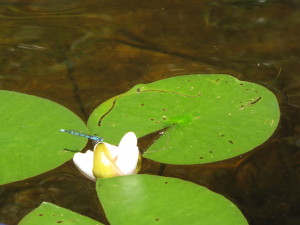A Day in the Life of An Invasive Plant Patroller on a Maine Lake
New Non-Conforming Structure Expansion Provision For Maine Lakefront Properties
July 31, 2014Out and About for the Bangor Lakes Region of Maine Aug. 7-13
August 7, 2014A Day in the Life of An Invasive Plant Patroller on a Maine Lake
Fragrant Water Lily, A Maine Native
by Leigh Macmillen Hayes
Volunteering as a plant patroller for your Maine lake or pond is a great way to learn how to protect your lake from those nasty invasive plants that destroy the recreational value of our properties. It’s easiest to view the plants from a low boat such as a kayak or canoe.
In Maine, we’re fortunate to have the Volunteer Lake Monitoring Program train us so we can learn to recognize the most common invasive plants and how to distinguish them from the native lookalikes.
After attending a training program put on by the VLMP this spring and making my own kayak view scope, the time had come to head out on Horseshoe Pond in Stoneham for an Invasive Aquatic Plant Screening Survey Workshop presented by VLMP’s Christine Guerette, Jackey Bailey and intern Dan Goettel.
Before leaving home, I needed to remember a few key items:
Kayak ✓
Paddles ✓
PFD ✓
Hat ✓
Polarized Sunglasses ✓
Water ✓
Lunch ✓
Sunscreen ✓
Quick Key ✓
Invasive Aquatic Plant Field Guide ✓
Documentation Forms ✓
Pencil and Clipboard ✓
Pocket Knife ✓
Zip-lock Bags, Permanent Marker and Cooler ✓
Hand lens ✓
Small White Tray ✓
Small rake ✓
Buoys ✓
OK, so there was hardly any room in the boat for me, but I made it work. Our group met at the boat launch, where a Certified Boat Inspector examined each craft, checking to make sure that we weren’t bringing any invasives into Horseshoe Pond.
On shore, Guerette, Bailey and Goettel took turns explaining how to get started. The goal is to survey the littoral area, looking for suspicious plants (Variable Water-milfoil, Hydrilla, Eurasian Water-milfoil, Curly Leaf Pondweed, European Naiad, Fanwort, Parrot Feather, European Frogbit, Water Chestnut, Yellow Floating Heart and Brazilian Elodea) and recording their locations on a map of the lake or pond. They reviewed survey procedures with us, including gear, maps and how to break the waterbody into sectors.
Then we headed off in teams of three, trying to paddle in a straight line from the shore out to an imaginary point and back to the same shoreline we’d started from, but aiming for a spot further along, creating a pie slice. As we moved along on the glass-like surface of the water, we scanned the bottom, looking at plants. Though we were looking for invasives, we were also familiarizing ourselves with the natives.
Occasionally, we used a small rake to gather specimens — trying to determine upon closer look whether friend or foe. It’s then that the boat wandered a bit, and I realized that I should have added anchor to my list. But, I tried to make a mental note of my location by looking at the shore, as I snipped a piece of the plant and floated it in the white tray. With my hand lens, I could see the minute features — serrated teeth or lack thereof; forked, branched or feathered leaves; etc.
Ultimately, we would have determined the depth of the plant observation and documented this on our survey form, as well as mapped our progress, but our time was limited for this initial search. Fortunately, no invasives were found.
We did, however, all bring back samples and the three professionals from VLMP helped us identify them by pointing out similarities and differences between the natives and invasives.
Click here to see another training session at the Narrows on Kezar Lake in Lovell.
The problem is that the eleven most unwanted invaders in Maine have look a-likes that are native. Had we found an invasive, we would have marked the location with a buoy, noted its location and depth on the map, completed documentation about the lake and its whereabouts, snipped a piece of the plant and placed it in a zip-lock bag 1/3 full of water and stored it in a cooler. Then we would have contacted VLMP and shipped the plant to them so they could make an exact identification.
Should you find a suspicious plant, DO NOT attempt to pull it out by its roots. Try to gently snip or break off a stem section about 6-8 inches long from the top portion of the plant. VLMP says for “rooted floating-leaved plants, be sure to include as much of the stem as possible.” Specimens must be kept alive, so place them in water and refrigerate until you can mail to VLMP for confirmation. Contact VLMP about how to ship the plant to them at 24 Maple Hill Road, Auburn, Maine 04210.
To learn more about lakefront properties for sale in Stoneham, Maine, click on the green box above.
To learn more about the Stoneham and Lovell area of western Maine, check out the blog links below.
Stoneham, Maine: Home to Picturesque Keewaydin Lake and the Peaceful Waters of Virginia Lake
Maine Lakefront Lovers Want Their “Special K” – Kezar and Keewaydin

